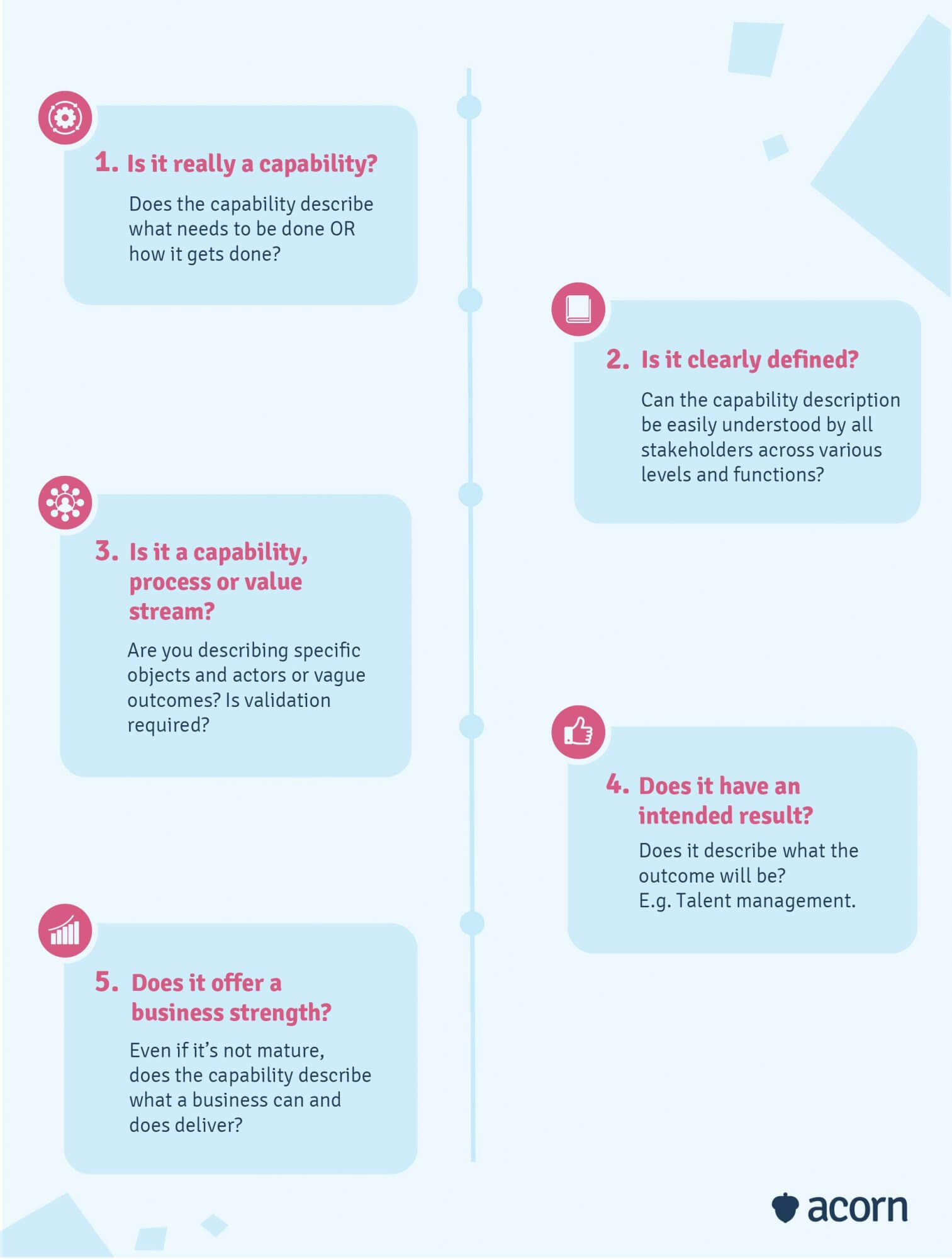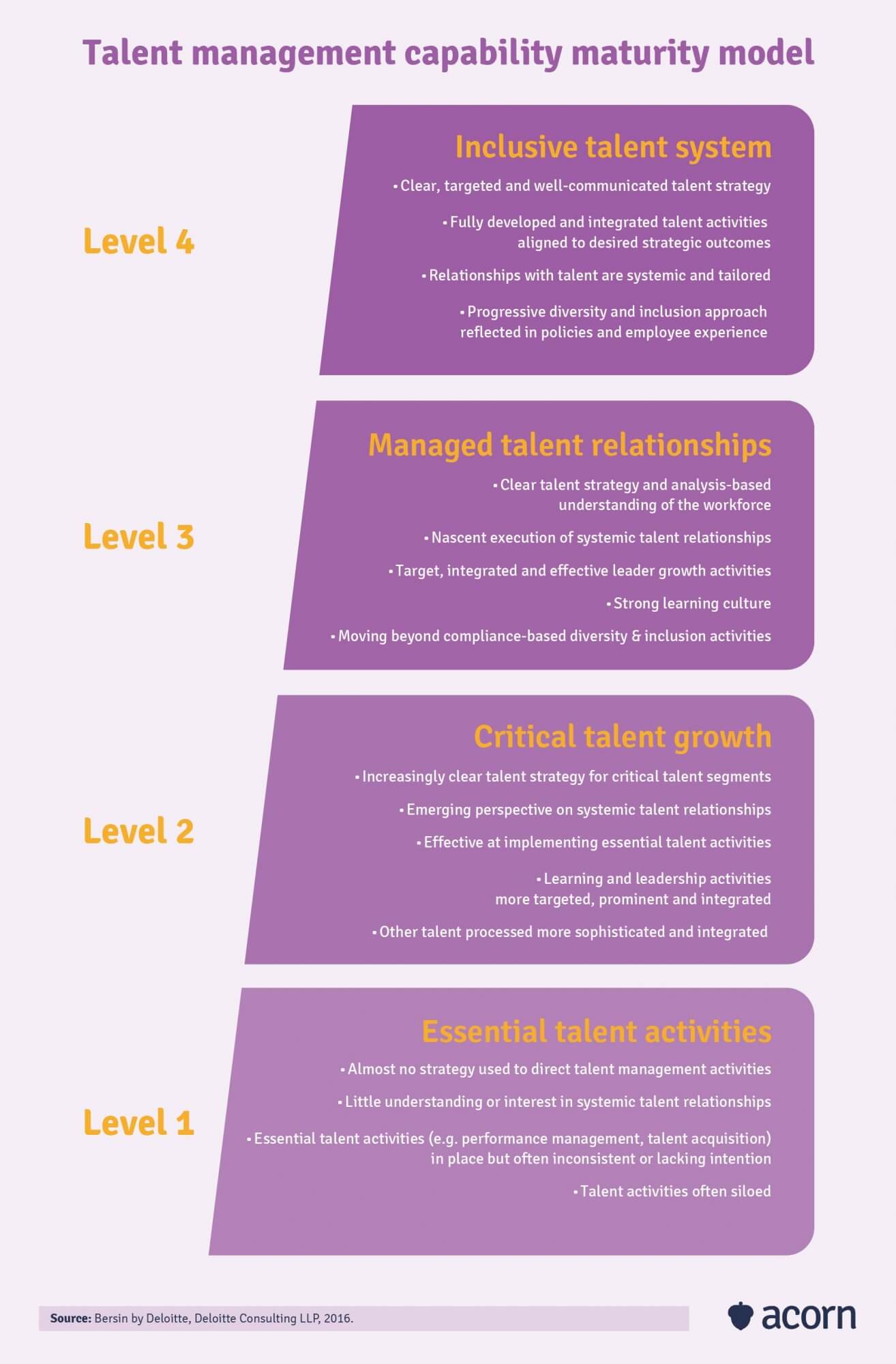How to Identify Capabilities When Running Business Architecture
Reading Time:

Lead the pack with the latest in strategic L&D every month— straight to your inbox.
SubscribeBusiness architecture is often a why, what, and how approach. Why your organisation is doing what it does, and exactly how it does it.
The what of that equation is always expressly focused on aligning strategy and execution, which is where business capabilities come into play.
In this article, we’ll walk through how to design business capabilities for your organisation, why they’re an important tool for business architects, and how to dispel negative perceptions of business architecture internally.
What is a business capability?
A business capability describes what an organisation can do in terms of business processes, tools, systems, talent, and structure.
Business capabilities:
- Create a universal language around how to align business strategy with processes and technology.
- Offer organisational neutrality, in that sudden or emerging changes don’t affect plans.
- Enable all stakeholders to identify what is strategically important at any given time, making for more informed decision-making.
- Provide a basis for prioritising investments for business improvement.
Why capabilities are important in business architecture
Many organisations struggle to effectively design a business strategy, let alone execute it. And you can forget the decisions made along the way to strategy, because they too are often based on misguided notions of business needs and priorities.
The problem can generally be traced back to an ill-formed big picture of a business. That leads to challenges like:
- Difficulty benchmarking market performance on a global scale. (Do you know how all your assets combined contribute to strategic goals?)
- Ill-informed budget investments. The squeaky wheel often gets the grease in business, but that can divert resources away from high priority tasks. What are truly strategic investments, and what are simply futile fiscal choices?
- Smaller tactics not supporting strategic goals. The larger the enterprise, the more likely many change initiatives are occurring concurrently and independently of one another. Do you know how to ensure those are aligned with strategy?
As we always like to say, capabilities are the mortar to the (strategic) bricks of your organisation. They keep your organisation at large focused on the greater goals you’re all working to achieve. This is essentially the heart of what business architects do in order to support strategic execution.
We pioneered the performance learning management system (PLMS) to enable organisations to discover, build, and assess their business capabilities. It’s the only solution that codifies and operationalises capabilities, giving employees individual learning recipes to master the specific capabilities of their roles and supercharge organisational performance.
But first, how exactly do you discover and define business capabilities?
How to design business capabilities
To start: Business capabilities describe a what, not a how (that would be tasks) or even a why (that’s the organisation’s mission). Each capability encompasses a number of tasks, processes, tools and people that are highly valuable to your business.
As a rule, a business capability:
- States both what a business can and must do to fulfil its mission.
- Describes the potential of what a business can do.
- Has offensive (to further strategy) and defensive (weather economic change) applications.
- Is cross-functional rather than tied to specific business areas.
- Is not tied to a specific implementation, but rather a whole-of-organisation, long-term strategy.
Without further ado, let’s dive into the steps of creating a business capability, including writing a capability definition, implementing them and how to monitor impact.
1. Consider long-term goals
As if enterprise architects weren’t already, you need to understand where your organisation wants to be compared to where it is now.
This makes that last criteria for defining business capabilities a little easier, especially if your default is to organise by business structure. It also means that stakeholders are less likely to seek out or try to prioritise their bit of the woods during business capability mapping, given a holistic view of business value streams.
So, to start segmenting your business architecture by capability, look to:
- Organisation of business units
- Key business processes
- Tactical demands
- Business objects.
You also need to look at this in the context of your organisation’s social fabric. If you stray too far away from that context, it’ll be hard to truly integrate business capabilities into everyday work. And since capabilities should be easily understood by all stakeholders (including those who perform them, i.e. your employees), you don’t want to be using business jargon to define them.
When considering the future, also keep in mind that capabilities should be sustainable. If they degrade easily, that either means one element of your business model is insecure or business architecture don’t understand their organisation’s mission.
2. Define value streams
Most business capability maps look at the ecosystem through which work gets done. By this, we mean think about value streams or business units.
Remember that above all, the golden rule is a capability describes a what. You can start high level or at the most granular level; our only advice on the latter point is to still have some idea of what your broader groupings of capabilities are to guide prioritisation.
Crucial means crucial here. If a business unit could do without a task or process, it’s not a true business capability. Examples include:
- Talent management
- Accounting
- Lead qualification
- IT security.
Note that these are short, sharp capability names that define an outcome. If you find yourself veering into using verbs, you’re back to value streams. Remember that a capability is only derived from them.

3. Define crucial tasks
You can think ahead with these capabilities, too. Very often the reason you’re introducing or revamping business capabilities is to drive business transformation. Ergo, you can workshop how said capabilities will fundamentally change the way in which work gets done to achieve new goals.
Consider granular levels of business capabilities in the frame of tools, processes and systems you need to be used or carried out by employees. The more you decompose capabilities, the more you should be looking at everyday work.
If we start at talent management, as an example, that decomposition may look something like this.

This is where you need to have buy-in from senior leaders and collaborate when linking business capabilities to their specific priorities. While you want broad and potentially cross-functional capabilities, you also need ensure you’re correctly articulating what is a crucial capability for enterprise architecture.
Assessing business capability maturity
Capability maturity is different to how you’d assess capability performance (which is done by a measure of competency).
The aim here is reaching a mature practice of business architecture and capability. That’s essentially a measurable way to effect process improvement and decrease potential risks.
This is generally evaluated across five levels of maturity.
- Initial: Business architecture does not exist, or if it does, it is not governed.
- Managed: Business architecture has articulated goals, but processes are still generally reactive.
- Defined: Key artefacts tend to emerge here, like capability (hello) maps, value stream maps and structure charts. Proactive processes occur.
- Quantitatively managed: Everything is measured and controlled with consistent data collection throughout the organisation.
- Optimising: It’s about maintenance and continuous improvement at this stage, because you have the architectural flexibility to innovate.
Think of this as self-discovery. There are a few things you can do to test business capability maturity. There are many external appraisals you can utilise, but if you’d like to be able to do an internal pulse check, you can gauge subject matter expert evaluations through specific assessment statements.
Heatmapping is also a great way to understand how capabilities are realised through employees compared to their proximity to strategy. If you have the technology to support it, you can better centralise and visualise this data.
Note that this information on its own doesn’t translate to a level of maturity, but shows you what requires investment and/or improvement. Over time, this data enables quicker, more proactive capability-based planning.
How to gain buy-in for business capabilities
The business architect sits firmly within the realm of business transformation. That’s a position not to be understated; aligning strategic objectives and tactics for execution is essentially the heart of business itself.
At its core, business architecture standardises and optimises four domains.
- What a business does
- The vocabulary it uses
- How the business is organised
- How it delivers value to stakeholders.
But it’s not enough to outline the business process for the function; you have to craft a story for why business capabilities are needed now.
But as with many operational endeavours, there can be perception issues with the discipline that prevent enterprise architecture solutions from getting off the ground. Said perception issues come with their own counter arguments when it comes to securing the collaboration you need to make capabilities stick.
- Business architecture is overly complicated. Really, you’re creating a foundational understanding of how the business is structured. It shouldn’t be any more complicated than naming what capabilities are needed where.
- It’s expensive. In-house functions may seem more like a cost centre than profit centre at first glance. However, most business capabilities need only one major implementation with some ongoing iteration through L&D — most of the cost to resources is upfront.
- It can be outsourced or licensed. Not if you want the requisite specificity and context that a business capability map should provide. You can pull general ideas from other maps, but in terms of competency and specific applications, custom is king here.
- HR or IT can do the work of business architects. The business architect represents and views the business as whole; other functions look at it through their singular strategic vantage point. Some issues simply may not be in their line of sight.
- The business capabilities map is the end goal. While one deliverable, it’s not the only one to strive for. Integration with wider business processes, validation of impact and capability refinement all fall under the business architect’s ongoing prerogative.
- Business architecture impedes agility. If anything, it enables and sustains it. Agility does not occur spontaneously; at the institutional level, mental models prioritise business capabilities by their strategic impact at any given time (both on the people and value stream front).
Key takeaways
It’s not really an argument of if business capabilities are important for business architects, but how you can effectively create and use them for value add.
Start by:
- Understanding long-term strategic goals
- Breaking down value streams or chains
- Outlining critical tasks within those streams.
To sustain business success with those capabilities, take initiative and consistently assess business capability maturity. This positions business architecture not only as key to business transformation, but also provides you with small wins to ensure business leaders buy into and participate in capability building initiatives.